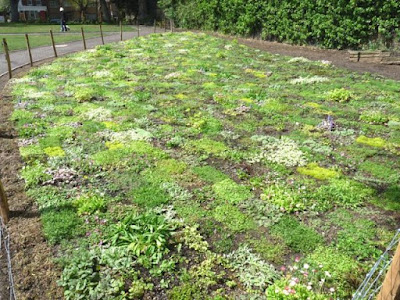Photo: Avondale garden one year after planting.
It’s the height of grass cutting season. I’m out there in
the garden twice a week with my hover mower taking the top growth of the grass
off before it gets too long to cut. Cutting grass isn’t the most enjoyable
thing I do in the garden but I must confess there is a sense of satisfaction
when it’s looking manicured and neat, in much the same way as tidying the house.
It’s more a case of doing the job because I know it’ll take longer if I don’t
keep on top of things and not because I love cleaning or cutting grass.
Confession
I’ve even considered getting artificial grass in some areas
and went as far as pricing some of this very environmentally unfriendly plastic
up the other week. It’s much the same as
buying a carpet, and for the type of material that actually looks like grass
and not something from the greengrocers table, it’s about the same price as a woolen
Axminster too.
Once the area to put the plastic grass is cleared of weeds,
the sand (or underlay you could say) has been put in and the edging has been
put in the artificial lawn could cost as much as €60 per square metre to lay.
It wouldn’t be so bad if that’s all that was needed, but there is an annual
maintenance of cleaning, weeding and brushing, so we might as well just stick
to real grass unless you are in a penthouse apartment with a small patio area
on the roof and can’t get the lawnmower in the lift.
Scrutiny
The idea of lawns is under scrutiny at the moment because
it’s classed as monoculture and isn’t really of benefit to the environment once
feeds and chemicals are applied, some people even resorte to sraying their dead grass with a green dye in summer. That and the fact they need watering and
cutting uses up vital resources. The natural lifecycle of grass is to die off a
lot in certain times of the year but we seem determined to keep it looking
green all year. Things get more worrying when we realise the smell of freshly
cut grass, so often comforting and nostalgic, is a chemical alarm call: a
bouquet of fragrant volatile organic compounds that plants release when under
attack.
Real Alternatives
Alternatives such as Avondale park in London developed by Lionel
Smith from reading University are totally grass free areas. You wouldn’t be
able to play football on them though as they are made from soft-stemmed perennial
plants that spread without using seed and live for longer than two years. Most
of them have been grown in a greenhouse to give them a good start and have
varieties such as red-flowered daisies (bellis), white-flowered buttercups
(ranunculus) and bronze-leaved bugle (ajuga). None of the plants have needed to
be watered since planting and no fertilizers are needed. The Grass-free lawns are
planned not exceed 3.5in (9cm) in height, or they will turn into a meadow.
Research indicates that grass-free lawns can produce up to
90% more flowers, contain over 25% more invertebrate life, and support up to
ten times as many visits from twice as many pollinator species as wildflower
turf. Mowing is reduced by up to two thirds, rainfall can be absorbed up to
twice as fast as a turf lawn and grass-free lawns need no chemical additives.- Ever.
The key to a good lawn made this way is that they can
multiply with runners or roots, and that they're allowed time to knit and blend
before the first cut. This type of
planting would only really be practical on small scale areas as it would be
quite difficult to grow and maintain the amount of plants for a rural garden
with an acre lawn.
Going back
Going back a few hundred years, lawns were not expanses of
unbroken green. Some medieval paintings of gardens depict carpets of turfgrass
stippled with various flowers, such as lily of the valley, poppies, cowslips,
primroses, wild strawberries, violets, daisies, and daffodils. People walked,
danced and relaxed on these flowery meads, which were meant to imitate natural
meadows. In the 15th and 16th centuries, we used white clover, chamomile,
thyme, yarrow, self-heal (Prunella vulgaris) and other low-growing meadow and
groundcover plants, sometimes mixed with grasses, to create lawns and pathways
on which to walk and mingle.
For most of history, however, mixed plant lawns and
non-grass lawns have been the exception, in part because a smooth, well-kept,
lush grass lawn became as much a symbol as a functional part of the property.
It’s not always practical to turn the garden into a vegetable plot either as
this would take a lot of time and need maintaining far more than a lawn.
So for
now there probably won’t be too much change in our garden landscape so the poor
old tortured grass will just have to stay.
